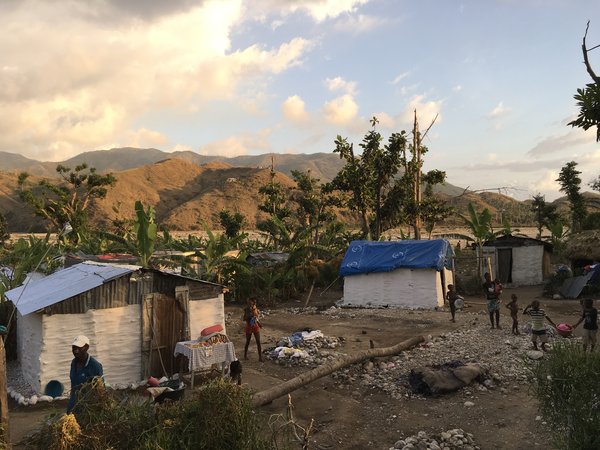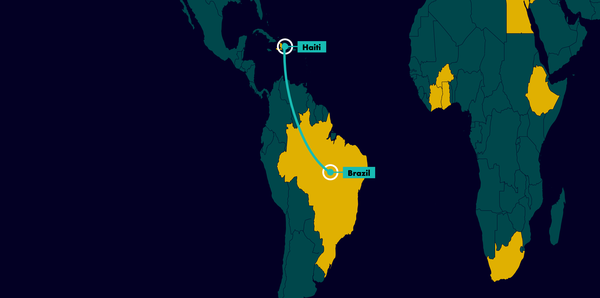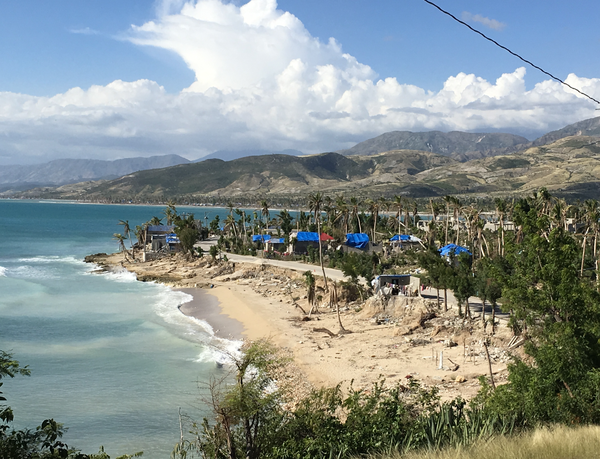
An IOM staff interviews families having recently crossed into Haiti from the Malpasse border crossing point. © IOM/Ilaria Lanzoni 2015
The current US-Mexico border crisis has been in the making for almost a decade. Many of those seeking refuge in the US today are Haitians who once sought the same across the Latin America and Caribbean (LAC) region, their hopes dashed by economic and socio-political crises and rising xenophobia.
Haitian migration to South America
In 2010, a significant shift in Haiti’s migration redirected aspiring migrants away from historic destinations such as the United States, Canada, and the Dominican Republic and toward South America. This shift had been in the making since the early 2000s and intensified in 2004, when US-backed oligarchs fomented an armed rebellion to topple the first democratically-elected President, Jean-Bertrand Aristide, which plunged Haiti into chaos. As a result, the human security situation in the country deteriorated to the point that the United Nations Security Council deemed Haiti a threat to international peace and created a Stabilization Mission (MINUSTAH) led by Brazil, an emerging power in South America. With the presence of MINUSTAH, a fragile stabilization mechanism was initiated. However, the socioeconomic situation worsened, leading to the 2007-2008 food riots. The riots revealed how the poverty and neglect experienced by Haitians undermined stabilization efforts. This crisis was followed by the devastating 2010 earthquake that took more than 200,000 lives while leaving little hope for change, particularly among Haiti’s youths. Compounding that disaster was the cholera epidemic introduced by United Nations’ soldiers in Haiti later that year, causing the deaths of more than 10,000 people and infecting more than 820,000 Haitians with a disease the country had been free of until then.
For those seeking to emigrate in the wake of these difficulties, Brazil emerged as a viable option. With increased demand for low-skilled labour in preparation for the impending 2014 World Cup and 2016 Olympic games, Brazil would lure Haitians, mostly males between 18 and 30 years of age, to South America. The post-earthquake surge in migration is evident from the numbers. Prior to 2010, less than 100 Haitians, mostly scholarship students, were living in Brazil. By 2018, that number would rise to more than 129,000, with over one-third granted humanitarian visas between 2012 and 2016. However, by 2015 Brazil’s attractiveness faded during the country’s economic downturn and political crisis, accompanied by rising xenophobia. Haitians began to look elsewhere, with many turning to Chile.
Sharing a border with Brazil, which allowed for circulation between the two countries, Chile’s economy and job opportunities drew Haitian migrants from across the Brazilian border and directly from Haiti. Between 2002 and 2018, the Haitian migrant population in Chile rose from 50 to over 100,000. The rising visibility of a large Black migrant population led to anti-Haitian sentiments that were exacerbated during the COVID-19 pandemic. With the 2017 election of conservative Sebastián Piñera, migration policy changes were introduced and tourist visas became a requirement for Haitian migrants. Additionally, in an act that received much criticism, a policy of “voluntary expulsion” of Haitian migrants was introduced in 2018. Haitians were no longer welcome in Chile.
Haiti’s migrants include the country’s most vibrant youth. They are high school and university graduates from lower middle-class families as well as the urban and rural poor who seek to escape poverty and inequities at home. Their hope is that they will encounter fewer obstacles abroad as they struggle to eke out a living in the Dominican Republic, on Chilean farms and vineyards, or in Brazilian meat-processing factories and construction sites.
The rising Haitian contingent of the Central American caravan has been well-documented over the past several years, their origins in South America captured in articles depicting the arduous journey as well as border clashes in countries such as Peru and Mexico. Since 2019, at the behest of the Trump administration, Panama and Mexico have played key roles in containing migrant flows from South and Central America, respectively. With full knowledge of the desperate and treacherous trek Haitians and other migrants had undertaken through the Darien Gap that connects South and Central America, migrant camps were set up by the Panamanian government at the request of the US government in an effort to intercept and deter migration to the US.
The context of a complex crisis
In Haiti, the past three years of anti-government and anti-corruption protests, an uninterrupted socio-political crisis, an economic crisis, rising gang violence and kidnappings, and several disasters culminating with a third earthquake in just over a decade, have brought us to where we are today. By the end of summer 2021, Haiti’s president had been assassinated, food prices rose sharply and daily transportation systems have been severely disrupted. Banks ceased operations for several days at a time, citing fuel shortages caused by gang violence and road blockades. Some areas in the Martissant neighbourhood of Port-au-Prince have been under siege for months due to gang turf wars that have threatened local residents and burned many homes. Gang activity has cut off most access to Haiti’s southern peninsula, the epicentre of the recent earthquake, at times disrupting humanitarian rescue and aid efforts. The country has become unliveable.
The instability experienced in Haiti that spurred migration to Latin America and now to the US-Mexico border is the result of complex crises. In many ways, these crises are linked to the lasting legacy of exploitative policies toward Haiti by the US and other countries. Thus, expecting short-term measures to stem migrant flows is akin to using duct tape to stop a pipe leak; it is a temporary fix, at best. We, who believe that people should be able to live in their homeland with dignity, must be prepared to protect migrant rights at the border while also ensuring that no Haitian ever has to make the difficult decision to leave their home out of desperation.
The international press is quick to draw our attention to Haiti’s problems: corrupt political leadership that underwrites poor governance and neutralizes the rule of law while rewarding systemic impunity and predatory monopolistic control of Haiti’s vital, but crippled, economic sectors by a few US-backed oligarch families and their political cronies. However, the crises of the present largely obscure the root causes: the maligned and corrosive power of US foreign policy toward Haiti; the deteriorating effects of foreign aid and international community approaches to development in Haiti; interference in Haiti’s elections by the Core Group, a group of US-led international diplomats; and the perverse effects of “humanitarian assistance”. These interventions have undermined the efforts of Haiti’s civil society, neutralized Haitians’ ability to invest in their communities, and turned the country into a republic of NGOs.
Failure to see the full picture prevents us from understanding that the migrant crisis is not a spontaneous event. It must be examined with respect to US and international engagement in Haiti and the policies that have either directly supported or turned a blind eye to corrupt leadership while demonstrating indifference to the Haitian population. The migrant crisis will not abate by redirecting Haitians to Mexico, Brazil, or Chile, as has now been implemented or is being considered, or inhumane mass deportations. Against all odds, human beings will always search for a better life, no matter the risk or cost, when the alternative is deprivation, violence, and even death.



